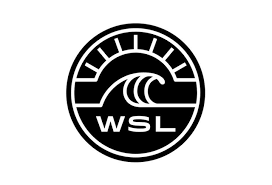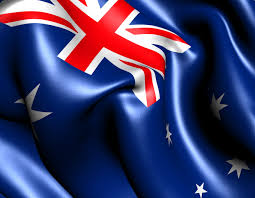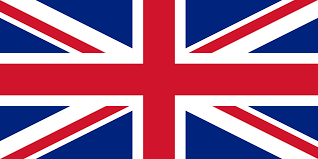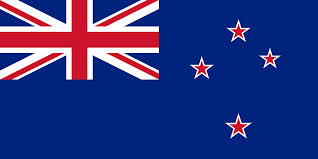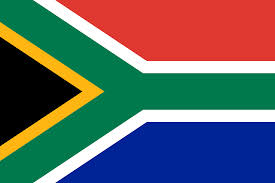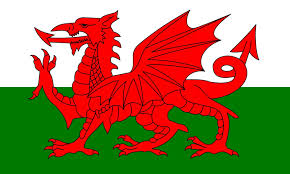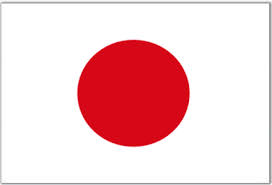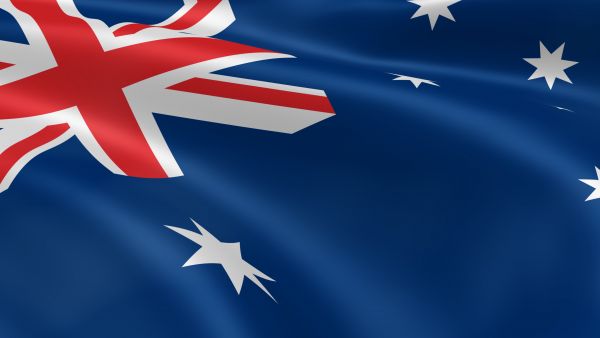International Surfing

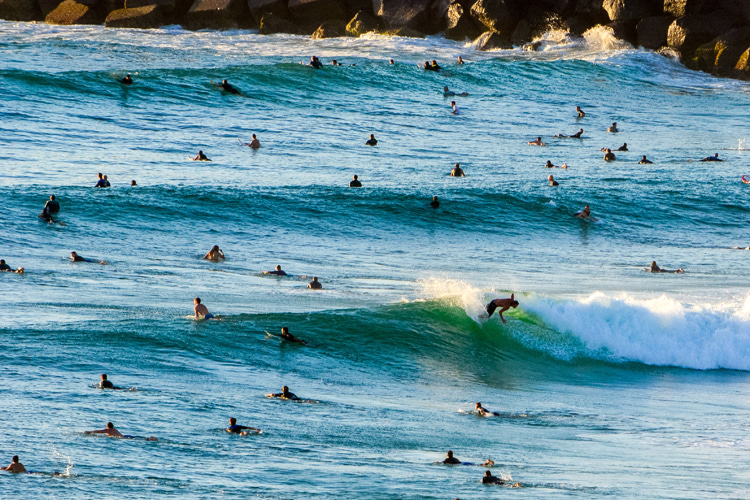
Life changes when you start working. And so does your surfing.
Most of the freedom and flexible time schedules you had before you became a grown-up adult with responsibilities and bills to pay ends or gets seriously axed when you get your first job.
The days when you could put on a wetsuit and just paddle out when the surf's great slowly vanish as you progress through your 20s and 30s.
Although this is not an inevitable scenario for every surfer out there, it's the most common one.
So, 99 percent of all hard-working recreational surfers end up with two days to shred and get their golden share of waves.
We end up in the so-called weekend warrior basket, the silent majority that surf media professionals, influencers, and wanna-be pro surfers often mock.
And then, if you commit the ultimate sin of starting a family, things get even worse for a while - weekends turn into months and years.
Some longtime surfers even lose the will to get in the water and enjoy the pleasures of catching a few "just like in the old times."
Passion fades away, and aging doesn't help either.
So, if Saturday and Sunday are the only days left for a quick surf escape, we try to make it work, come rain or come shine.
One of the best ways to transform these golden opportunities into pleasurable sessions is by choosing a consistent break, ideally close to home.
The problem is that we all follow the same rationale.
Consequently, beaches known for their average-to-good conditions all year round get crowded, if not impossibly crowded.
And then, on top of that, there's the uncontrolled surf school army, taking over the battlefield from the early hours of the morning until the sun sets and darkness kicks in.
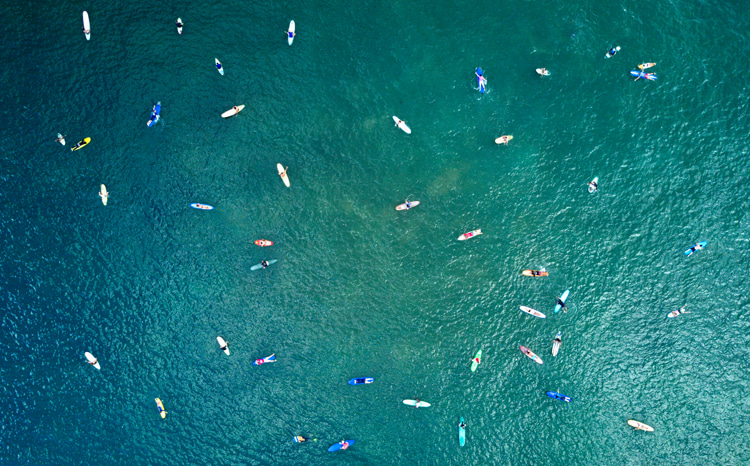
Pain Point Reached
One of these Saturdays, I exercised my weekend warrior right to ride a few good waves for an hour.
I tried to time the tides and be at the beach as early as a working man in his 40s could.
I guess I was ready to get wet before 9 in the morning.
By the time I was paddling out with my hair still dry, there were already a few partners in crime looking like they'd had their weekly share of fun.
No worries. The vibes were good.
However, in less than half an hour, I was already surrounded by dozens - literally - of first-timers wearing their multi-colored jerseys, each representing a surf school business.
Luck is also not on my side.
My home break is one of the busiest in Europe, located within bike, metro, or car distance from one of the most en-vogue tourist destinations in the Old Continent of the last decade.
Despite being a long beach break with multiple peaks that pump around 300 days of surfing a year, its resources are not infinite.
Moreover, space is limited.
And if you think you can teach beginner surfers the basic rules of surf etiquette, forget it.
They will not look left and right before paddling into a perfect wave or a close-out guillotine.
They don't care, and instructors often follow the pattern.
Suddenly, I was encircled by colored jerseys, soft-top surfboards, and all sorts of in-between set chats.
The word "surrounded" could fit in the concept of vital space a surfer needs to exercise their art.
But this wasn't the case. I had surf pupils within a board's reach.
I had to plan how to turn the board around to catch a wave. And when I was successful, there was another challenge ahead - to complete a ride.
I am not one of those who whistle or yell at others to ensure my priority is respected.
In case of imminent danger, I respectfully emit a warning - usually, "Attention!" - to avoid disaster, injuries, and surfboard dings.
So, every time I caught a wave, I would have a drop-in incident, putting an end to an average ride.
And then, they smile back at you while still riding their boards prone toward the beach.
One time is OK; twice could happen. But three, four, and five times is a pattern.
At some point, I decided to call it quits and paddled in.
As soon I was taking off my leash my leash, I looked back at the lineup and realized this wasn't surfing.
The peak I had chosen to release my weekly stress had around 20-30 people thinking they were having fun.
They were all six feet apart, probably thinking they were having the time of their lives.
I immediately told myself I would not come back here again on a weekend.
This was not surfing; this was not fun. I actually didn't even know what that was.
Was it masochism? The need to belong to a cool tribe? A photo-op for social media?
How can they feel they're experiencing the exhilarating rush of walking on water when there's so much noise and many boards around them?
As I walked up the beach, I felt equally frustrated and depressed.
Getting Away
I am one of those who believe the world would be a better place if more people surfed.
I am genuinely convinced my beloved pastime improves people's lives.
But I cannot deny that getting surfing into the mainstream and a wider audience is simultaneously killing the experience for everyone.
Is there a balance between these apparently opposing worlds? Where do you draw the line between healthy and enjoyable lineups and promoting surfing and its virtues?
In the past, I adopted the rule that tells my inner self to choose an average peak that is often less crowded instead of a quality wave where 100 weekend warriors are jockeying for position.
But the latest lesson learned is that I do have to drive away from my home break and try my luck in alternative spots where there's barely a soul breathing.
Until my new secret spot gets crowded, and I stop surfing forever. Is this my destiny, or am I getting old and picky?
Words by Luís MP | Founder of SurferToday.com
https://www.surfertoday.com/surfing/the-battle-for-waves-in-overcrowded-surf-breaks


Life changes when you start working. And so does your surfing.
Most of the freedom and flexible time schedules you had before you became a grown-up adult with responsibilities and bills to pay ends or gets seriously axed when you get your first job.
The days when you could put on a wetsuit and just paddle out when the surf's great slowly vanish as you progress through your 20s and 30s.
Although this is not an inevitable scenario for every surfer out there, it's the most common one.
So, 99 percent of all hard-working recreational surfers end up with two days to shred and get their golden share of waves.
We end up in the so-called weekend warrior basket, the silent majority that surf media professionals, influencers, and wanna-be pro surfers often mock.
And then, if you commit the ultimate sin of starting a family, things get even worse for a while - weekends turn into months and years.
Some longtime surfers even lose the will to get in the water and enjoy the pleasures of catching a few "just like in the old times."
Passion fades away, and aging doesn't help either.
So, if Saturday and Sunday are the only days left for a quick surf escape, we try to make it work, come rain or come shine.
One of the best ways to transform these golden opportunities into pleasurable sessions is by choosing a consistent break, ideally close to home.
The problem is that we all follow the same rationale.
Consequently, beaches known for their average-to-good conditions all year round get crowded, if not impossibly crowded.
And then, on top of that, there's the uncontrolled surf school army, taking over the battlefield from the early hours of the morning until the sun sets and darkness kicks in.

Pain Point Reached
One of these Saturdays, I exercised my weekend warrior right to ride a few good waves for an hour.
I tried to time the tides and be at the beach as early as a working man in his 40s could.
I guess I was ready to get wet before 9 in the morning.
By the time I was paddling out with my hair still dry, there were already a few partners in crime looking like they'd had their weekly share of fun.
No worries. The vibes were good.
However, in less than half an hour, I was already surrounded by dozens - literally - of first-timers wearing their multi-colored jerseys, each representing a surf school business.
Luck is also not on my side.
My home break is one of the busiest in Europe, located within bike, metro, or car distance from one of the most en-vogue tourist destinations in the Old Continent of the last decade.
Despite being a long beach break with multiple peaks that pump around 300 days of surfing a year, its resources are not infinite.
Moreover, space is limited.
And if you think you can teach beginner surfers the basic rules of surf etiquette, forget it.
They will not look left and right before paddling into a perfect wave or a close-out guillotine.
They don't care, and instructors often follow the pattern.
Suddenly, I was encircled by colored jerseys, soft-top surfboards, and all sorts of in-between set chats.
The word "surrounded" could fit in the concept of vital space a surfer needs to exercise their art.
But this wasn't the case. I had surf pupils within a board's reach.
I had to plan how to turn the board around to catch a wave. And when I was successful, there was another challenge ahead - to complete a ride.
I am not one of those who whistle or yell at others to ensure my priority is respected.
In case of imminent danger, I respectfully emit a warning - usually, "Attention!" - to avoid disaster, injuries, and surfboard dings.
So, every time I caught a wave, I would have a drop-in incident, putting an end to an average ride.
And then, they smile back at you while still riding their boards prone toward the beach.
One time is OK; twice could happen. But three, four, and five times is a pattern.
At some point, I decided to call it quits and paddled in.
As soon I was taking off my leash my leash, I looked back at the lineup and realized this wasn't surfing.
The peak I had chosen to release my weekly stress had around 20-30 people thinking they were having fun.
They were all six feet apart, probably thinking they were having the time of their lives.
I immediately told myself I would not come back here again on a weekend.
This was not surfing; this was not fun. I actually didn't even know what that was.
Was it masochism? The need to belong to a cool tribe? A photo-op for social media?
How can they feel they're experiencing the exhilarating rush of walking on water when there's so much noise and many boards around them?
As I walked up the beach, I felt equally frustrated and depressed.
Getting Away
I am one of those who believe the world would be a better place if more people surfed.
I am genuinely convinced my beloved pastime improves people's lives.
But I cannot deny that getting surfing into the mainstream and a wider audience is simultaneously killing the experience for everyone.
Is there a balance between these apparently opposing worlds? Where do you draw the line between healthy and enjoyable lineups and promoting surfing and its virtues?
In the past, I adopted the rule that tells my inner self to choose an average peak that is often less crowded instead of a quality wave where 100 weekend warriors are jockeying for position.
But the latest lesson learned is that I do have to drive away from my home break and try my luck in alternative spots where there's barely a soul breathing.
Until my new secret spot gets crowded, and I stop surfing forever. Is this my destiny, or am I getting old and picky?
Words by Luís MP | Founder of SurferToday.com
https://www.surfertoday.com/surfing/the-battle-for-waves-in-overcrowded-surf-breaks

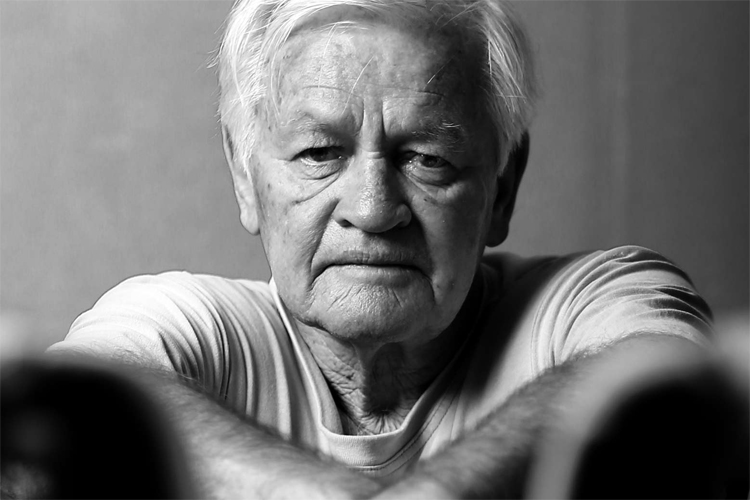
Geoff McCoy, one of the world's most innovative and creative surfboard shapers, passed away at home in Byron Bay, Australia, at the age of 79 after complications following a heart attack.
The pioneer of the shortboard revolution was born in 1944 in Gosford, New South Wales.
As a youngster, the son of a farmer and the Killcare Surf Club captain was a talented horseman.
Geoff started surfing at age 14 during his school holidays at Avoca Beach.
He shaped his first boards at 17 for Bennett Surfboards and Keyo Surfboards after concluding a five-year apprenticeship in wood and metal pattern making.
He was also the co-founder of M&M Surfboards.
In the 1970s, the Australian set up his own business, McCoy Surfboards, in Brookvale, a Sydney suburb.
Ray Richards, the father of world surfing champion Mark Richards, encouraged him to do so and ordered the shaper's first ten creations.
In just half a year, the McCoy factory produced 65 boards weekly.
It marked a vibrant era as Geoff crafted boards for numerous top surfers and embarked on his inaugural journey to Hawaii.
In 1978, Geoff dedicated a year to California, establishing McCoy USA and collaborating with Jeff Hakman on design innovations.
By then, McCoy had shifted his factory to Avoca Beach on the NSW Central Coast, laying the foundation for the expanding McCoy empire across Japan, the USA, and Hawaii.
Geoff's instinctive desire to experiment and try new things got him into the world of twin-fin surfboards, making him one of the first Aussies to shape them.
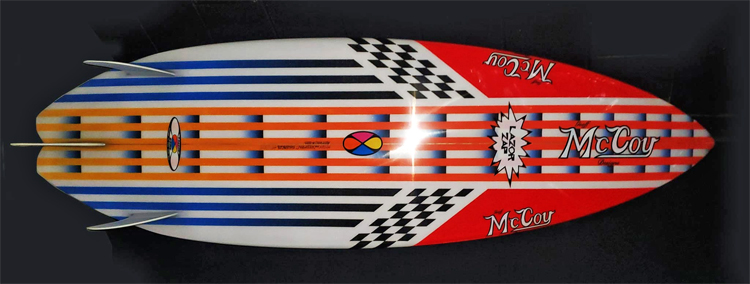
The Lazor Zap
However, what really changed for the NSW surfer-shaper was the famous "Lazor Zap," a surfboard model with a steep rocker and a sharp nose.
The board allowed surfers to get more vertical, engage in tighter top-to-bottom surf lines, and take more risks while performing radical maneuvers.
According to surf historian Matt Warshaw, the "Lazor Zap" allowed surfers to "move the board's trimming sweet spot - usually a foot or so ahead of where the rider stands while turning - back toward the tail section so that, in theory, the surfer would not have to move their feet."
The magical model helped team rider Cheyne Horan lock in two runner-up finishes in the 1981 and 1981 ASP World Tour.
Here's how Geoff McCoy described his iconic template:
"The concept of the 'Lazor Zap' is based on my energy theory, which explains how energy turns into wave formation and how objects react with those formations."
"The original 'Lazor Zap' was designed with short arc, reactive high-powered surfing in mind. The surfer was able to stand in one position, not having to move their feet to perform their maneuvers and this is exactly how the boards performed."
"The pulled nose allowed the board to elevate very quickly as it reduced the length of rail being used when the board is turning."
"In turn, this allowed for more maneuvers to be performed while the surfer was standing in a fixed position on the wide thick supportive tail which generates greater pressure and easier reaction."
"The advantages were many - easier to paddle, stand in one position to ride the wave, quicker reaction from the extra volume, easier turning from less resistance, and ability to surf at a faster speed."
"In effect, everything required from them, the 'Lazor Zap' designs delivered at all levels of performance."
An Inspiring Surfboard Craftsman
McCoy's lineup also featured other groundbreaking designs, such as the "Nugget," "Quazor Zip," and "Astron Zot," each presenting its distinct features and riding opportunities.
Simon Anderson's thruster revolution soon eclipsed McCoy's avant-garde models and designs sold via Lost and Channel Islands.
But the mentor of the three-fin setup would Call Geoff one of the five inspiring figures behind the thruster.
Meanwhile, a business manager hired by Geoff methodically accumulated debt for McCoy.
The shaper became aware of this when a longstanding associate inquired about outstanding payments.
Geoff contacted the manager from Sydney, only to find the accounts wiped from the computer upon his return to the Avoca factory.
He had lost around 500,000 dollars.
Faced with bankruptcy or receivership, bankruptcy was unthinkable for Geoff, who valued honor and integrity.
Reluctantly, he placed the flourishing business under receivership, liquidating assets to settle debts in 1984.
McCoy never stopped shaping boards - in Hawaii, Tweed Heads, and Byron Bay - or inspiring craftspeople worldwide to rethink his greatest models.
The man who spread the tear-drop-shaped surfboard smoothly blended philosophy, pragmatism, and technically superior foam-mowing skills into his out-of-the-box designs.
In 2018, Geoff highlighted the surfers who profoundly influenced his shaping philosophy: Gerry Lopez for hold and release, Midget Farrelly for the outline, and Nat Young for rails.
McCoy might have left us, but his rideable legacy lives.
Words by Luís MP | Founder of SurferToday.com
https://www.surfertoday.com/surfing/geoff-mccoy-the-father-of-the-lazor-zap-passes-away


Geoff McCoy, one of the world's most innovative and creative surfboard shapers, passed away at home in Byron Bay, Australia, at the age of 79 after complications following a heart attack.
The pioneer of the shortboard revolution was born in 1944 in Gosford, New South Wales.
As a youngster, the son of a farmer and the Killcare Surf Club captain was a talented horseman.
Geoff started surfing at age 14 during his school holidays at Avoca Beach.
He shaped his first boards at 17 for Bennett Surfboards and Keyo Surfboards after concluding a five-year apprenticeship in wood and metal pattern making.
He was also the co-founder of M&M Surfboards.
In the 1970s, the Australian set up his own business, McCoy Surfboards, in Brookvale, a Sydney suburb.
Ray Richards, the father of world surfing champion Mark Richards, encouraged him to do so and ordered the shaper's first ten creations.
In just half a year, the McCoy factory produced 65 boards weekly.
It marked a vibrant era as Geoff crafted boards for numerous top surfers and embarked on his inaugural journey to Hawaii.
In 1978, Geoff dedicated a year to California, establishing McCoy USA and collaborating with Jeff Hakman on design innovations.
By then, McCoy had shifted his factory to Avoca Beach on the NSW Central Coast, laying the foundation for the expanding McCoy empire across Japan, the USA, and Hawaii.
Geoff's instinctive desire to experiment and try new things got him into the world of twin-fin surfboards, making him one of the first Aussies to shape them.

The Lazor Zap
However, what really changed for the NSW surfer-shaper was the famous "Lazor Zap," a surfboard model with a steep rocker and a sharp nose.
The board allowed surfers to get more vertical, engage in tighter top-to-bottom surf lines, and take more risks while performing radical maneuvers.
According to surf historian Matt Warshaw, the "Lazor Zap" allowed surfers to "move the board's trimming sweet spot - usually a foot or so ahead of where the rider stands while turning - back toward the tail section so that, in theory, the surfer would not have to move their feet."
The magical model helped team rider Cheyne Horan lock in two runner-up finishes in the 1981 and 1981 ASP World Tour.
Here's how Geoff McCoy described his iconic template:
"The concept of the 'Lazor Zap' is based on my energy theory, which explains how energy turns into wave formation and how objects react with those formations."
"The original 'Lazor Zap' was designed with short arc, reactive high-powered surfing in mind. The surfer was able to stand in one position, not having to move their feet to perform their maneuvers and this is exactly how the boards performed."
"The pulled nose allowed the board to elevate very quickly as it reduced the length of rail being used when the board is turning."
"In turn, this allowed for more maneuvers to be performed while the surfer was standing in a fixed position on the wide thick supportive tail which generates greater pressure and easier reaction."
"The advantages were many - easier to paddle, stand in one position to ride the wave, quicker reaction from the extra volume, easier turning from less resistance, and ability to surf at a faster speed."
"In effect, everything required from them, the 'Lazor Zap' designs delivered at all levels of performance."
An Inspiring Surfboard Craftsman
McCoy's lineup also featured other groundbreaking designs, such as the "Nugget," "Quazor Zip," and "Astron Zot," each presenting its distinct features and riding opportunities.
Simon Anderson's thruster revolution soon eclipsed McCoy's avant-garde models and designs sold via Lost and Channel Islands.
But the mentor of the three-fin setup would Call Geoff one of the five inspiring figures behind the thruster.
Meanwhile, a business manager hired by Geoff methodically accumulated debt for McCoy.
The shaper became aware of this when a longstanding associate inquired about outstanding payments.
Geoff contacted the manager from Sydney, only to find the accounts wiped from the computer upon his return to the Avoca factory.
He had lost around 500,000 dollars.
Faced with bankruptcy or receivership, bankruptcy was unthinkable for Geoff, who valued honor and integrity.
Reluctantly, he placed the flourishing business under receivership, liquidating assets to settle debts in 1984.
McCoy never stopped shaping boards - in Hawaii, Tweed Heads, and Byron Bay - or inspiring craftspeople worldwide to rethink his greatest models.
The man who spread the tear-drop-shaped surfboard smoothly blended philosophy, pragmatism, and technically superior foam-mowing skills into his out-of-the-box designs.
In 2018, Geoff highlighted the surfers who profoundly influenced his shaping philosophy: Gerry Lopez for hold and release, Midget Farrelly for the outline, and Nat Young for rails.
McCoy might have left us, but his rideable legacy lives.
Words by Luís MP | Founder of SurferToday.com
https://www.surfertoday.com/surfing/geoff-mccoy-the-father-of-the-lazor-zap-passes-away

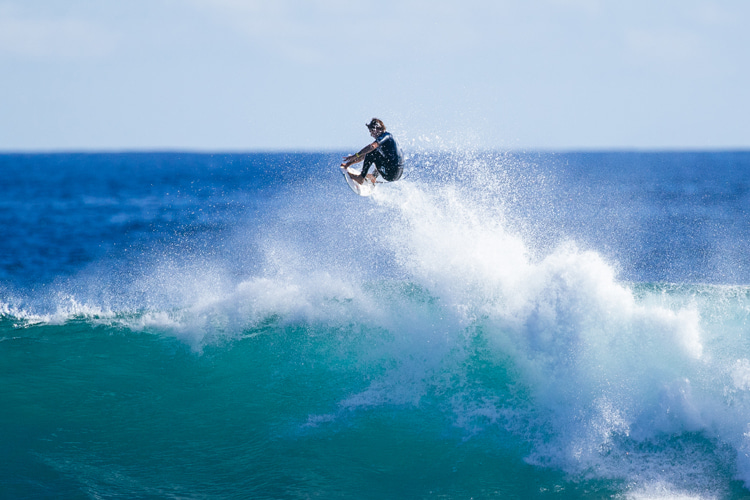
Jack Robinson and Gabriela Bryan have taken out the 2024 Margaret River Pro.
In a full day of competition that ran 18 heats, Bryan and Robinson took down a stacked field in six-to-eight-foot waves at Margaret River's Main Break.
As the final event before the mid-season cut, the surfers left in the draw had one last opportunity to continue through to the back half of the 2024 CT season.
Today's high-pressured heats confirmed the final list of competitors who made and missed the mid-season cut.
Gabriela Bryan Claims Maiden CT Victory
Coming into Margaret River Pro, Gabriela Bryan was sitting in 10th place on the rankings and in desperate need of her best result of the year.
A standout at Margaret River, Bryan has made the final at this location before to save her place on Tour with a career-best runner-up finish in her rookie season.
The 22-year-old's path to the Final was a rocky one, with plenty of close results seeing her edge out her opponents, Costa Rica's Brisa Hennessy and Australia's India Robinson.
Bryan saved her best surfing for last against 2024 CT Rookie Sawyer Lindblad (USA) in the Final, where she posted her best heat total of the week, a 15.93 (out of a possible 20), to claim her maiden CT victory and move up to No. 5 on the world rankings.
"I don't even know what to say. I'm so happy right now," Bryan said.
"It's been a crazy day, crazy week, crazy month. I'm so happy to get this win and proud to do it when my back was against the wall. I couldn't do this alone, though. My mom, my dad, my brother, and my sister support me so much."
"Seabass [Sebastian Zietz] has supported me so much. There are so many people at home, and I hope I've made them all proud. This is insane, and I don't even know if it's sunk in yet."
The women's Final saw eventual winner and 2022 Western Australia Margaret River Pro runner-up Bryan take on rookie Lindblad on a day that has once again seen the next generation of female competitors raise the bar.
For the majority of the 35-minute matchup, both women held mid-range heat totals without separating Linblad's vertical backhand approach from Bryan's frontside power hacks.
Then, with less than five minutes left, Bryan found the biggest wave of the set and laid down a huge frontside carve, then finished with a super late, critical rebound to earn an excellent 8.10 (out of a possible 10) to take the win.
"I was coming into this event under the cut, and now I'm No. 5, which makes a big difference," continued Bryan.
"It's just reassuring knowing my surfing belongs on Tour. I'm so happy we got good waves today."
"Last year, I was eliminated from this event and relied on things going my way to make the cut, so it was so good to do it myself and do what I needed to do."
"All the girls put on such a good show today. When I kicked out of that wave, I knew it was sent to me by someone - with those dolphins riding it - it was amazing."
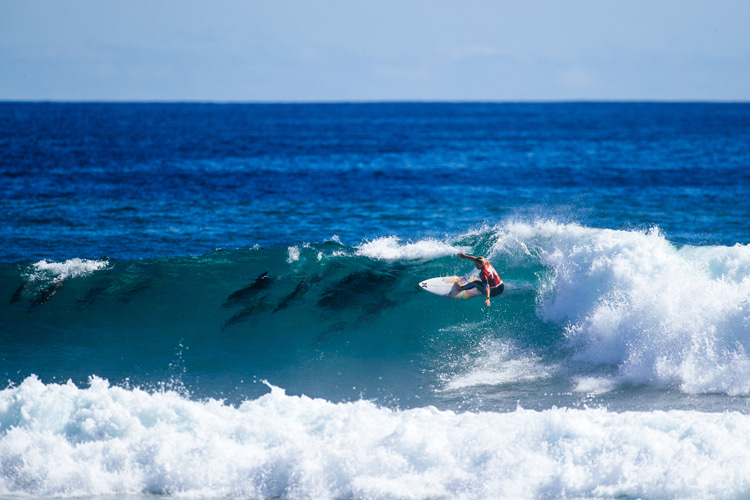
Robinson Earns Second CT Victory at Margaret River
After winning the 2022 Western Australia Margaret River Pro, a knee injury early last season robbed Jack Robinson of defending the title at his home break.
This year saw Robinson get his opportunity, and after an early exit at Bells Beach, the young Australian World Title hopeful looked destined for the Final from his performances today.
Robinson built through the day and, in the Final against John John Florence, posted the second-highest heat total of the event to claim his second win in front of his hometown crowd, friends, and family.
"I missed last year and went through so much to get back and get through that injury, so I felt like this year I was defending my title," Robinson said.
"I'm feeling good. That's the final I wanted, and I wanted to throw everything at it. It's always fun surfing against John."
"We will have many more heats in the future, I'm sure. What a day. I'm super humbled to be here and win at my home, and I'm so grateful for this moment."
The men's Final saw local boy Robinson come up against Main Break standout Florence in a matchup of the two event standouts.
Florence looked to be the man to beat coming in, but Robinson had other ideas, posting a 9.10 for three huge carves on one of the biggest waves of the event, then backing it up with an 8.17 for a massive frontside straight air with three turns to complete the wave.
Robinson's 17.27 heat total (out of a possible 20) was the second-highest of the event and left Florence needing a Perfect 10 to take the lead.
Florence posted an 8.10 to lower the requirement but couldn't find another set wave, leaving Robinson to take the win and equal Florence with two Main Break victories in what was one of the heats of the event.
With this being his second CT win of the year, Robinson moves to second on the rankings heading into Tahiti, where he is the defending event winner.
"John John fires me so much, and I always look forward to heats with him," Robinson continued.
"There's no one else I'd rather final with than John. Watching him out here inspired me so much. He set the benchmark. It's not just me who won; it's everyone who supports me."
"It's an incredible moment. To come back here after traveling all year is special. It's my home, and it's the best place in the world. And I'm grateful to be here right now."
Last Mid-Season Cut Qualifiers
Sally Fitzgibbons, the 15-year CT veteran, needed to win the entire event to save herself from the cut.
In a battle with 2024 CT rookie Sawyer Lindblad, the two competitors played a patient game, with former Margaret River winner Fitzgibbons holding the advantage with only two waves surfed.
With everything on the line, Lindblad threw everything at a medium set with only seconds remaining to earn a 5.50 and the win by just 0.50 of a point.
For Fitzgibbons, it's the second consecutive year she will be forced to return to the Challenger Series, a tour she dominated in 2023.
Bryan won her heat against India Robinson in the first Quarterfinal to make the cut and secure her position on the Tour for her third straight season.
Robinson, who needed to win the entire event to avoid relegation, put up a strong fight, but she fell less than 2 points shy in the Main Break conditions.
With a massive comeback to start the day in Heat 5 of the men's Round of 16, Moniz saved himself from the cut in the dying minutes of his heat against World No. 2 Ethan Ewing.
With time escaping the Hawaiian, he had one final opportunity that paid off with an excellent 8.17 and the win.
Moniz went on to face Robinson, where the close matchup saw the West Australian get the win with a narrow 0.63-point advantage.
Brazilian Caio Ibelli was unable to take down eventual Quarterfinalist Smith.
His loss in the Round of 16, Heat 6, means that he missed the cut, while the result also cleared the way for Connor O'Leary (JPN) to qualify.
Ibelli will head back to the Challenger Series, which kicks off in exactly one week at the Bonsoy Gold Coast Pro at the famed Snapper Rocks.
Joining Ibelli at Snapper will be Samuel Pupo (BRA) after his loss to Florence in the first Quarterfinal.
An excellent performance from Florence, with a 16.26 combined score, was too much for Pupo to defeat with a 14.17.
Pupo relegated his older brother in the Round of 16, and they'll now do battle to requalify for the Tour together via the Challenger Series.
Pupo's also loss provided the opening and confirmation for Yago Dora to be the final men's competitor to clear the mid-season cut.
2024 Margaret River Pro | Finals
Women
- Gabriela Bryan (HAW) 15.93
- Sawyer Lindblad (USA) 13.94
Men
- Jack Robinson (AUS) 17.27
- John John Florence (HAW) 16.04
Made the Cut
Men
- Griffin Colapinto
- Jack Robinson
- John John Florence
- Ethan Ewing
- Jordy Smith
- Jake Marshall
- Barron Mamiya
- Cole Houshmand
- Kanoa Igarashi
- Liam O'Brien
- Imaikalani deVault
- Crosby Colapinto
- Seth Moniz
- Rio Waida
- Ramzi Boukhiam
- Italo Ferreira
- Leonardo Fioravanti
- Ryan Callinan
- Gabriel Medina
- Matthew McGillivray
- Connor O'Leary
- Yago Dora
Relegated
- Samuel Pupo
- Ian Gentil
- Caio Ibelli
- Miguel Pupo
- Kade Matson
- Jacob Willcox
- Frederico Morais
- Callum Robson
- Eli Hanneman
- Kelly Slater
- Deivid Silva
- Joao Chianca
- Filipe Toledo
Women
- Caitlin Simmers
- Johanne Defay
- Molly Picklum
- Brisa Hennessy
- Gabriela Bryan
- Caroline Marks
- Bettylou Sakura Johnson
- Tyler Wright
- Tatiana Weston-Webb
- Sawyer Lindblad
Relegated
- Lakey Peterson
- Luana Silva
- Sally Fitzgibbons
- Isabella Nichols
- India Robinson
- Alyssa Spencer
- Sophie McCulloch
- Carissa Moore
https://www.surfertoday.com/surfing/jack-robinson-and-gabriela-bryan-win-2024-margaret-river-pro


Jack Robinson and Gabriela Bryan have taken out the 2024 Margaret River Pro.
In a full day of competition that ran 18 heats, Bryan and Robinson took down a stacked field in six-to-eight-foot waves at Margaret River's Main Break.
As the final event before the mid-season cut, the surfers left in the draw had one last opportunity to continue through to the back half of the 2024 CT season.
Today's high-pressured heats confirmed the final list of competitors who made and missed the mid-season cut.
Gabriela Bryan Claims Maiden CT Victory
Coming into Margaret River Pro, Gabriela Bryan was sitting in 10th place on the rankings and in desperate need of her best result of the year.
A standout at Margaret River, Bryan has made the final at this location before to save her place on Tour with a career-best runner-up finish in her rookie season.
The 22-year-old's path to the Final was a rocky one, with plenty of close results seeing her edge out her opponents, Costa Rica's Brisa Hennessy and Australia's India Robinson.
Bryan saved her best surfing for last against 2024 CT Rookie Sawyer Lindblad (USA) in the Final, where she posted her best heat total of the week, a 15.93 (out of a possible 20), to claim her maiden CT victory and move up to No. 5 on the world rankings.
"I don't even know what to say. I'm so happy right now," Bryan said.
"It's been a crazy day, crazy week, crazy month. I'm so happy to get this win and proud to do it when my back was against the wall. I couldn't do this alone, though. My mom, my dad, my brother, and my sister support me so much."
"Seabass [Sebastian Zietz] has supported me so much. There are so many people at home, and I hope I've made them all proud. This is insane, and I don't even know if it's sunk in yet."
The women's Final saw eventual winner and 2022 Western Australia Margaret River Pro runner-up Bryan take on rookie Lindblad on a day that has once again seen the next generation of female competitors raise the bar.
For the majority of the 35-minute matchup, both women held mid-range heat totals without separating Linblad's vertical backhand approach from Bryan's frontside power hacks.
Then, with less than five minutes left, Bryan found the biggest wave of the set and laid down a huge frontside carve, then finished with a super late, critical rebound to earn an excellent 8.10 (out of a possible 10) to take the win.
"I was coming into this event under the cut, and now I'm No. 5, which makes a big difference," continued Bryan.
"It's just reassuring knowing my surfing belongs on Tour. I'm so happy we got good waves today."
"Last year, I was eliminated from this event and relied on things going my way to make the cut, so it was so good to do it myself and do what I needed to do."
"All the girls put on such a good show today. When I kicked out of that wave, I knew it was sent to me by someone - with those dolphins riding it - it was amazing."

Robinson Earns Second CT Victory at Margaret River
After winning the 2022 Western Australia Margaret River Pro, a knee injury early last season robbed Jack Robinson of defending the title at his home break.
This year saw Robinson get his opportunity, and after an early exit at Bells Beach, the young Australian World Title hopeful looked destined for the Final from his performances today.
Robinson built through the day and, in the Final against John John Florence, posted the second-highest heat total of the event to claim his second win in front of his hometown crowd, friends, and family.
"I missed last year and went through so much to get back and get through that injury, so I felt like this year I was defending my title," Robinson said.
"I'm feeling good. That's the final I wanted, and I wanted to throw everything at it. It's always fun surfing against John."
"We will have many more heats in the future, I'm sure. What a day. I'm super humbled to be here and win at my home, and I'm so grateful for this moment."
The men's Final saw local boy Robinson come up against Main Break standout Florence in a matchup of the two event standouts.
Florence looked to be the man to beat coming in, but Robinson had other ideas, posting a 9.10 for three huge carves on one of the biggest waves of the event, then backing it up with an 8.17 for a massive frontside straight air with three turns to complete the wave.
Robinson's 17.27 heat total (out of a possible 20) was the second-highest of the event and left Florence needing a Perfect 10 to take the lead.
Florence posted an 8.10 to lower the requirement but couldn't find another set wave, leaving Robinson to take the win and equal Florence with two Main Break victories in what was one of the heats of the event.
With this being his second CT win of the year, Robinson moves to second on the rankings heading into Tahiti, where he is the defending event winner.
"John John fires me so much, and I always look forward to heats with him," Robinson continued.
"There's no one else I'd rather final with than John. Watching him out here inspired me so much. He set the benchmark. It's not just me who won; it's everyone who supports me."
"It's an incredible moment. To come back here after traveling all year is special. It's my home, and it's the best place in the world. And I'm grateful to be here right now."
Last Mid-Season Cut Qualifiers
Sally Fitzgibbons, the 15-year CT veteran, needed to win the entire event to save herself from the cut.
In a battle with 2024 CT rookie Sawyer Lindblad, the two competitors played a patient game, with former Margaret River winner Fitzgibbons holding the advantage with only two waves surfed.
With everything on the line, Lindblad threw everything at a medium set with only seconds remaining to earn a 5.50 and the win by just 0.50 of a point.
For Fitzgibbons, it's the second consecutive year she will be forced to return to the Challenger Series, a tour she dominated in 2023.
Bryan won her heat against India Robinson in the first Quarterfinal to make the cut and secure her position on the Tour for her third straight season.
Robinson, who needed to win the entire event to avoid relegation, put up a strong fight, but she fell less than 2 points shy in the Main Break conditions.
With a massive comeback to start the day in Heat 5 of the men's Round of 16, Moniz saved himself from the cut in the dying minutes of his heat against World No. 2 Ethan Ewing.
With time escaping the Hawaiian, he had one final opportunity that paid off with an excellent 8.17 and the win.
Moniz went on to face Robinson, where the close matchup saw the West Australian get the win with a narrow 0.63-point advantage.
Brazilian Caio Ibelli was unable to take down eventual Quarterfinalist Smith.
His loss in the Round of 16, Heat 6, means that he missed the cut, while the result also cleared the way for Connor O'Leary (JPN) to qualify.
Ibelli will head back to the Challenger Series, which kicks off in exactly one week at the Bonsoy Gold Coast Pro at the famed Snapper Rocks.
Joining Ibelli at Snapper will be Samuel Pupo (BRA) after his loss to Florence in the first Quarterfinal.
An excellent performance from Florence, with a 16.26 combined score, was too much for Pupo to defeat with a 14.17.
Pupo relegated his older brother in the Round of 16, and they'll now do battle to requalify for the Tour together via the Challenger Series.
Pupo's also loss provided the opening and confirmation for Yago Dora to be the final men's competitor to clear the mid-season cut.
2024 Margaret River Pro | Finals
Women
- Gabriela Bryan (HAW) 15.93
- Sawyer Lindblad (USA) 13.94
Men
- Jack Robinson (AUS) 17.27
- John John Florence (HAW) 16.04
Made the Cut
Men
- Griffin Colapinto
- Jack Robinson
- John John Florence
- Ethan Ewing
- Jordy Smith
- Jake Marshall
- Barron Mamiya
- Cole Houshmand
- Kanoa Igarashi
- Liam O'Brien
- Imaikalani deVault
- Crosby Colapinto
- Seth Moniz
- Rio Waida
- Ramzi Boukhiam
- Italo Ferreira
- Leonardo Fioravanti
- Ryan Callinan
- Gabriel Medina
- Matthew McGillivray
- Connor O'Leary
- Yago Dora
Relegated
- Samuel Pupo
- Ian Gentil
- Caio Ibelli
- Miguel Pupo
- Kade Matson
- Jacob Willcox
- Frederico Morais
- Callum Robson
- Eli Hanneman
- Kelly Slater
- Deivid Silva
- Joao Chianca
- Filipe Toledo
Women
- Caitlin Simmers
- Johanne Defay
- Molly Picklum
- Brisa Hennessy
- Gabriela Bryan
- Caroline Marks
- Bettylou Sakura Johnson
- Tyler Wright
- Tatiana Weston-Webb
- Sawyer Lindblad
Relegated
- Lakey Peterson
- Luana Silva
- Sally Fitzgibbons
- Isabella Nichols
- India Robinson
- Alyssa Spencer
- Sophie McCulloch
- Carissa Moore
https://www.surfertoday.com/surfing/jack-robinson-and-gabriela-bryan-win-2024-margaret-river-pro

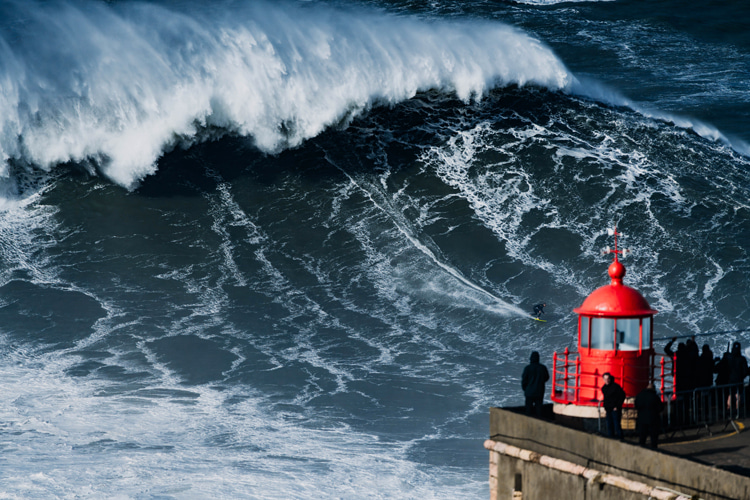
Big wave surfing is an industry with an industry.
The relentless chase for world records translates into prize money and sponsorship deals.
Athletes have been pushing their limits and putting their lives on the line to ride bigger and heavier waves.
Top athletes now work with multidisciplinary teams involving personal trainers, psychologists, nutritionists, photo and videographers, and public relations professionals.
This 360-degree approach brings world-renowned big riders closer to their goal of holding the record for the largest wave ever surfed.
Sebastian Steudtner is one of them.
The German holds the coveted Guinness World Record trophy validated by the World Surf League.
But the 2023/2024 winter season was particularly rich in XXL swells and potentially world record-breaking feats.
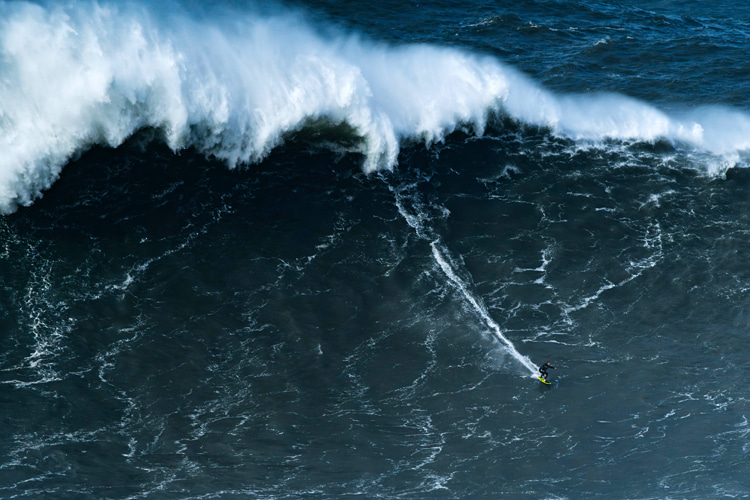
Drones to Measure Wave Height
So, because the best defense is the attack, Steudtner leveraged "state-of-the-art drone technology" developed by Porsche Engineering to measure one of his best recent rides at Nazaré.
The drone prototype from the joint technology project between Team Steudtner and Porsche Engineering was used during this winter's XXL swell.
According to the German team, the device determines the height of waves quickly and precisely.
The prototype is equipped with cameras, control units, and storage devices.
In addition, sensors are used in vehicle development to support modern driver assistance systems.
The drone can measure all areas of the wave and the surfer within a radius of about 100 meters.
"We are very pleased to have created an innovative solution that can advance the sport of surfing," says Marcus Schmelz, Project Manager at Porsche Engineering.
"It was a challenge to develop a drone that can measure not only the height of the waves but is also capable of tracking the surfer within the radius throughout the entire wave ride."
Porsche Engineering's drone measured Sebastian's wave at Nazaré at 93.73 feet (28.57 meters). The wave was caught and ridden on February 24, 2024.
The current world record, also held by Steudtner, is 86.4 feet (26.21 meters), which was achieved at Nazaré in 2020.
The current official WSL measurement model uses video footage and still images to determine wave height.
"We are open to sharing our technical insights from the drone development with official experts," adds Schmelz.
"Our goal is to further increase transparency in big wave surfing and to provide accurate measurement data more quickly."
Porsche's drone is not the first to fly over waves and measure them.
In 2020, Teddy Allen and Milan Curcic created Henet Wave, a similar, portable unmanned aerial vehicle (UAV) that works as an aerial surf buoy.
The device was tested in 2022 and has been continuously updated.
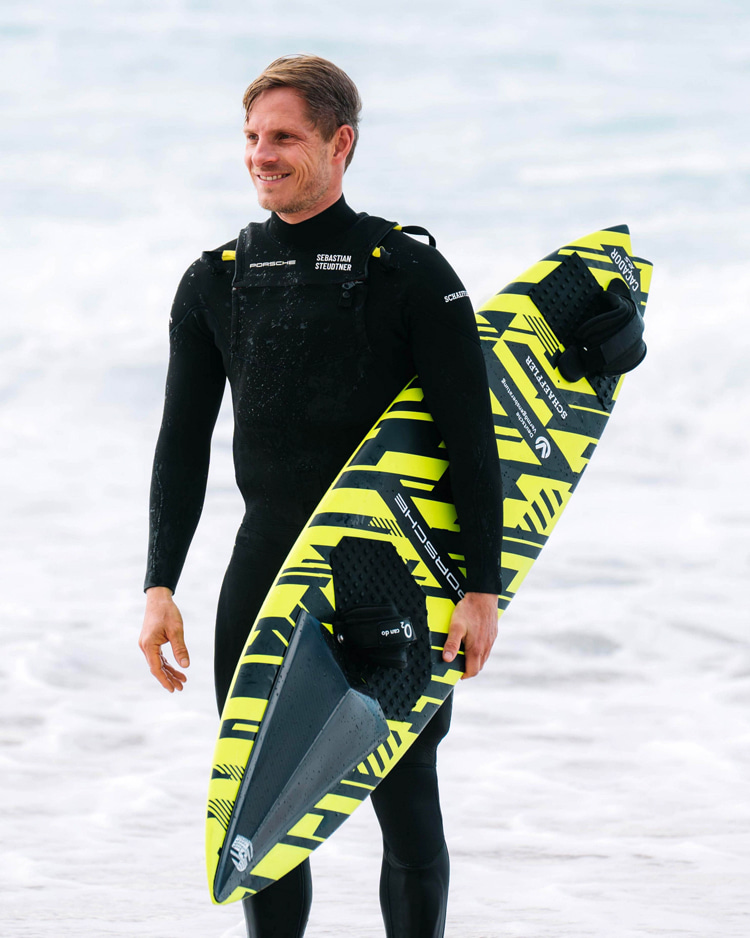
Mission Wave Alpha
Sebastian Steudtner's entourage is one of the strongest in the field.
The German is backed up by several multinational corporations, including Porsche, Porsche Engineering, Schaeffler, O2 Germany, Deutsche Vermögensberatung, X-BIONIC, and others.
He recently set up Mission Wave Alpha, a project that aims to get Steudtner surfing waves twice the size of the current world record, i.e., 130-160 feet (40-50 meters).
These brands are helping him push the sport to the next level on all fronts, from water safety to board materials and design.
Over the past three years, Steudtner, in partnership with Porsche Engineering and Schaeffler, has developed and optimized new surfboard technology to get him surfing the biggest waves possible.
For instance, to reduce water and air resistance, a fundamental variable in surfing, the surfer and his tech team used the latest simulation methods and wind tunnel validations.
As a result, with the new board "Caçador RS," Steudtner says he can now reach speeds of up to 100 kilometers per hour, compared to the previous 80 kilometers per hour.
Higher speed is critical to riding larger waves because the taller a wave is, the faster the surfer must be so that it doesn't overrun him.
Now, this speed advantage enabled Steudtner to ride the potential next record wave.
"I am very proud to be able to bring big wave surfing to the next level through the development of safety and technology and by believing in my dream," concludes Sebastian Steudtner.
"Together with my team, which is driven by its unique 'can do' mindset to define possible in big-wave surfing, we were able to accomplish this mission."
The race for the world's largest wave ever surfed is on, with Lucas "Chumbo" Chianca also claiming a potential record in Praia do Norte, Nazaré, Portugal.
Words by Luís MP | Founder of SurferToday.com
https://www.surfertoday.com/surfing/sebastian-steudtner-and-porsche-develop-wave-height-measurement-drone


Big wave surfing is an industry with an industry.
The relentless chase for world records translates into prize money and sponsorship deals.
Athletes have been pushing their limits and putting their lives on the line to ride bigger and heavier waves.
Top athletes now work with multidisciplinary teams involving personal trainers, psychologists, nutritionists, photo and videographers, and public relations professionals.
This 360-degree approach brings world-renowned big riders closer to their goal of holding the record for the largest wave ever surfed.
Sebastian Steudtner is one of them.
The German holds the coveted Guinness World Record trophy validated by the World Surf League.
But the 2023/2024 winter season was particularly rich in XXL swells and potentially world record-breaking feats.

Drones to Measure Wave Height
So, because the best defense is the attack, Steudtner leveraged "state-of-the-art drone technology" developed by Porsche Engineering to measure one of his best recent rides at Nazaré.
The drone prototype from the joint technology project between Team Steudtner and Porsche Engineering was used during this winter's XXL swell.
According to the German team, the device determines the height of waves quickly and precisely.
The prototype is equipped with cameras, control units, and storage devices.
In addition, sensors are used in vehicle development to support modern driver assistance systems.
The drone can measure all areas of the wave and the surfer within a radius of about 100 meters.
"We are very pleased to have created an innovative solution that can advance the sport of surfing," says Marcus Schmelz, Project Manager at Porsche Engineering.
"It was a challenge to develop a drone that can measure not only the height of the waves but is also capable of tracking the surfer within the radius throughout the entire wave ride."
Porsche Engineering's drone measured Sebastian's wave at Nazaré at 93.73 feet (28.57 meters). The wave was caught and ridden on February 24, 2024.
The current world record, also held by Steudtner, is 86.4 feet (26.21 meters), which was achieved at Nazaré in 2020.
The current official WSL measurement model uses video footage and still images to determine wave height.
"We are open to sharing our technical insights from the drone development with official experts," adds Schmelz.
"Our goal is to further increase transparency in big wave surfing and to provide accurate measurement data more quickly."
Porsche's drone is not the first to fly over waves and measure them.
In 2020, Teddy Allen and Milan Curcic created Henet Wave, a similar, portable unmanned aerial vehicle (UAV) that works as an aerial surf buoy.
The device was tested in 2022 and has been continuously updated.

Mission Wave Alpha
Sebastian Steudtner's entourage is one of the strongest in the field.
The German is backed up by several multinational corporations, including Porsche, Porsche Engineering, Schaeffler, O2 Germany, Deutsche Vermögensberatung, X-BIONIC, and others.
He recently set up Mission Wave Alpha, a project that aims to get Steudtner surfing waves twice the size of the current world record, i.e., 130-160 feet (40-50 meters).
These brands are helping him push the sport to the next level on all fronts, from water safety to board materials and design.
Over the past three years, Steudtner, in partnership with Porsche Engineering and Schaeffler, has developed and optimized new surfboard technology to get him surfing the biggest waves possible.
For instance, to reduce water and air resistance, a fundamental variable in surfing, the surfer and his tech team used the latest simulation methods and wind tunnel validations.
As a result, with the new board "Caçador RS," Steudtner says he can now reach speeds of up to 100 kilometers per hour, compared to the previous 80 kilometers per hour.
Higher speed is critical to riding larger waves because the taller a wave is, the faster the surfer must be so that it doesn't overrun him.
Now, this speed advantage enabled Steudtner to ride the potential next record wave.
"I am very proud to be able to bring big wave surfing to the next level through the development of safety and technology and by believing in my dream," concludes Sebastian Steudtner.
"Together with my team, which is driven by its unique 'can do' mindset to define possible in big-wave surfing, we were able to accomplish this mission."
The race for the world's largest wave ever surfed is on, with Lucas "Chumbo" Chianca also claiming a potential record in Praia do Norte, Nazaré, Portugal.
Words by Luís MP | Founder of SurferToday.com
https://www.surfertoday.com/surfing/sebastian-steudtner-and-porsche-develop-wave-height-measurement-drone

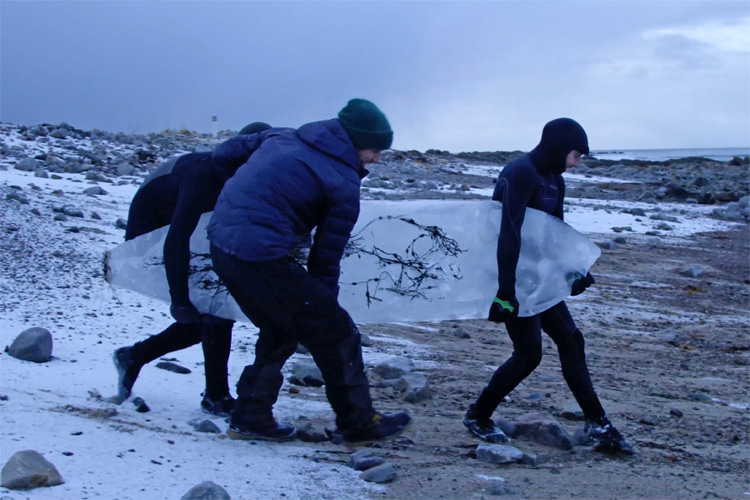
Is it possible to shape a surfboard out of ice? And if you make it a reality, can you surf it?
They're probably the world's most sustainable surfboards, made from the same core of waves - water.
The physics of surfboards and surfing tell us that gravity and buoyancy play fundamental roles in moving the rideable surface across the wave.
These two forces only need a stable, relatively wide, and long stiff material to propel a human over the water.
One of the first to come up with the idea of a surfboard made of frozen water was Conn Bertish, a surfer, artist, and ocean protection activist, who crafted a life-sized surfboard completely out of ice in 2009.
Bertish spent two days sculpting the ice board in a specialized fridge in Cape Town, South Africa.
Afterward, the board was transported in two pieces to Depasco Café, where it was showcased to the public as part of the Wavescapes Surf Art Exhibition.
The goal was to highlight the impact of global warming on our oceans and the rapid melting of glaciers and ice caps worldwide.
So, if ice is solid and floats, why can't it be shaped and turned into a real rideable surfboard?
Well, that was exactly what Nordics and Scandinavians thought when they first created these innovative surf craft.
If there's a resource they can harvest nearly infinite quantities, it is ice.
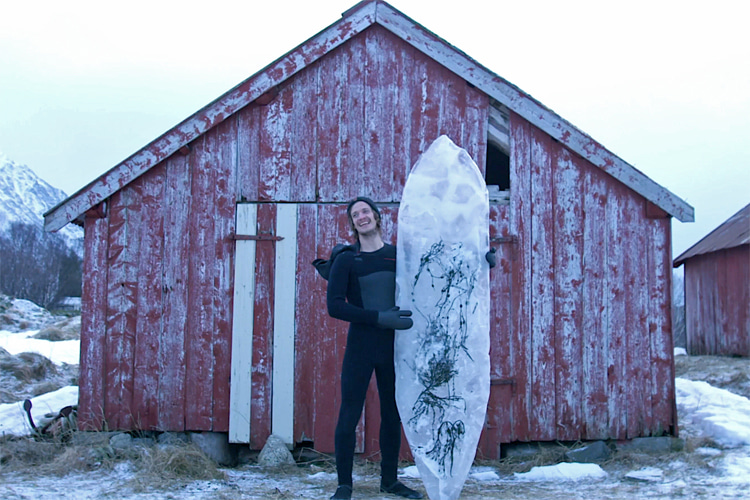
The Pioneering Norwegian Experiment
In 2019, Lofoten-based filmmaker Inge Wegge shot "Ice Edge," a short movie about a Norwegian collective trying to shape surfboards made of ice.
The team included seasoned surfers, a professional ice sculptor, and a local shaper.
It was a trial-and-error process, as different shaping techniques had to be tested, and carving ice blocks above the Arctic Circle is not something anyone can do.
Nothing was ruled out: longer and shorter templates, finless and non-finless setups, the use of sand to increase grip, and even embedded LED lights.
Soon, they realized they needed around 20-30 frozen surfboards and a boat to carry them to the lineup and town surfers into the waves.
All of this is in -10 °C of air temperature that often feels like -25 °C due to wind.
At first, they tried cutting ice from frozen lakes, but it didn't work.
Then they made molds from plastic and wood, filled them with fresh water, added seaweed for grip, and some other things for fun.
They put the boards in a room at -25 °C for two days in a fishery before testing them in the waves.
They tried out the boards for four days, carrying heavy 70-kilogram creations to the water.
The boards lasted about 30 minutes in the 3 °C ocean water before melting away, with only about five minutes of good surfing conditions.
They needed extra help to push the heavy boards into the waves for enough speed to catch them.
This kind of surfing is riskier than regular surfing because falling onto a 60-70-kilogram ice board can hurt.
After several days of trying, they nailed it, making ice surfboarding a reality.
Wakesurfing with an Ice Board in Minnesota
In 2021, professional ice sculptor Trevor Pearson fulfilled a dream: to shape a surfboard from a single piece of ice.
He meticulously designed it to resemble the shape and dimensions of a traditional surfboard, making it slightly larger to enhance water displacement and improve riding stability.
The thickness of the ice board was also considered to ensure it could withstand a surfer while balancing weight and buoyancy.
The experiment took place on a day when the ice had just melted on Eagle Lake in Minnesota.
Trevor and friends took the wake boat out, put the two and a half to three-inch thick board in the water, and realized it held up surprisingly well.
Their only enemy was temperature.
Trevor's experience on the ice board involved a delicate balance between staying upright and monitoring the board's condition.
As he rode, he had to assess the thickness of the ice beneath him, noticing it gradually thinning with each run.
The board was melting. Despite the inevitable, Trevor managed to navigate the ice board for a while before it eventually snapped in half.
The 50-pound Transparent Surfboard
In April 2024, professional wakesurfer Sam Studee challenged local company Minnesota Ice to shape a wakeboard out of frozen water.
The result was two 50-pound transparent boards swiftly tested in a nearby lake's cool waters.
The ride was a success; he was literally surfing on water, even though the boards melted and broke in half in 30 seconds.
How did Studee not slip? The real-life Cody Maverick drilled screws through his shoes for traction.
Words by Luís MP | Founder of SurferToday.com
https://www.surfertoday.com/surfing/a-brief-history-of-ice-surfboards


Is it possible to shape a surfboard out of ice? And if you make it a reality, can you surf it?
They're probably the world's most sustainable surfboards, made from the same core of waves - water.
The physics of surfboards and surfing tell us that gravity and buoyancy play fundamental roles in moving the rideable surface across the wave.
These two forces only need a stable, relatively wide, and long stiff material to propel a human over the water.
One of the first to come up with the idea of a surfboard made of frozen water was Conn Bertish, a surfer, artist, and ocean protection activist, who crafted a life-sized surfboard completely out of ice in 2009.
Bertish spent two days sculpting the ice board in a specialized fridge in Cape Town, South Africa.
Afterward, the board was transported in two pieces to Depasco Café, where it was showcased to the public as part of the Wavescapes Surf Art Exhibition.
The goal was to highlight the impact of global warming on our oceans and the rapid melting of glaciers and ice caps worldwide.
So, if ice is solid and floats, why can't it be shaped and turned into a real rideable surfboard?
Well, that was exactly what Nordics and Scandinavians thought when they first created these innovative surf craft.
If there's a resource they can harvest nearly infinite quantities, it is ice.

The Pioneering Norwegian Experiment
In 2019, Lofoten-based filmmaker Inge Wegge shot "Ice Edge," a short movie about a Norwegian collective trying to shape surfboards made of ice.
The team included seasoned surfers, a professional ice sculptor, and a local shaper.
It was a trial-and-error process, as different shaping techniques had to be tested, and carving ice blocks above the Arctic Circle is not something anyone can do.
Nothing was ruled out: longer and shorter templates, finless and non-finless setups, the use of sand to increase grip, and even embedded LED lights.
Soon, they realized they needed around 20-30 frozen surfboards and a boat to carry them to the lineup and town surfers into the waves.
All of this is in -10 °C of air temperature that often feels like -25 °C due to wind.
At first, they tried cutting ice from frozen lakes, but it didn't work.
Then they made molds from plastic and wood, filled them with fresh water, added seaweed for grip, and some other things for fun.
They put the boards in a room at -25 °C for two days in a fishery before testing them in the waves.
They tried out the boards for four days, carrying heavy 70-kilogram creations to the water.
The boards lasted about 30 minutes in the 3 °C ocean water before melting away, with only about five minutes of good surfing conditions.
They needed extra help to push the heavy boards into the waves for enough speed to catch them.
This kind of surfing is riskier than regular surfing because falling onto a 60-70-kilogram ice board can hurt.
After several days of trying, they nailed it, making ice surfboarding a reality.
Wakesurfing with an Ice Board in Minnesota
In 2021, professional ice sculptor Trevor Pearson fulfilled a dream: to shape a surfboard from a single piece of ice.
He meticulously designed it to resemble the shape and dimensions of a traditional surfboard, making it slightly larger to enhance water displacement and improve riding stability.
The thickness of the ice board was also considered to ensure it could withstand a surfer while balancing weight and buoyancy.
The experiment took place on a day when the ice had just melted on Eagle Lake in Minnesota.
Trevor and friends took the wake boat out, put the two and a half to three-inch thick board in the water, and realized it held up surprisingly well.
Their only enemy was temperature.
Trevor's experience on the ice board involved a delicate balance between staying upright and monitoring the board's condition.
As he rode, he had to assess the thickness of the ice beneath him, noticing it gradually thinning with each run.
The board was melting. Despite the inevitable, Trevor managed to navigate the ice board for a while before it eventually snapped in half.
The 50-pound Transparent Surfboard
In April 2024, professional wakesurfer Sam Studee challenged local company Minnesota Ice to shape a wakeboard out of frozen water.
The result was two 50-pound transparent boards swiftly tested in a nearby lake's cool waters.
The ride was a success; he was literally surfing on water, even though the boards melted and broke in half in 30 seconds.
How did Studee not slip? The real-life Cody Maverick drilled screws through his shoes for traction.
Words by Luís MP | Founder of SurferToday.com
https://www.surfertoday.com/surfing/a-brief-history-of-ice-surfboards
 - All Sports
- All Sports















